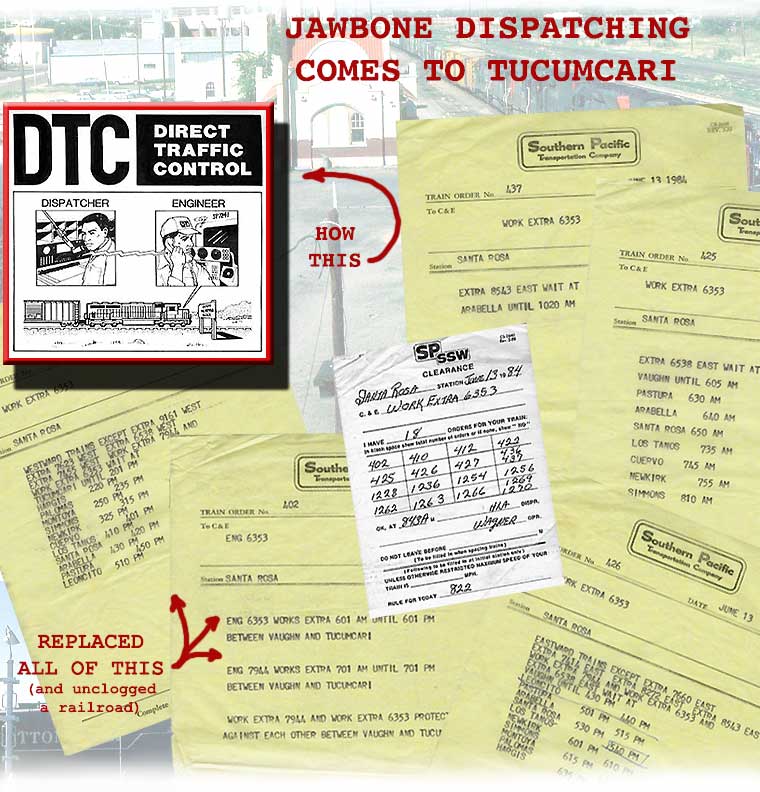
 |
| It's different now: UP instead of SP; CTC instead of train orders; crews operating under alcohol testing, instead of under the influence. Tucumcari's not even in the Carrizozo Sub anymore.
|
||||||
|
But back in the early 1980's, the Carrizozo Sub was an amazing place. In just a few short years, Southern Pacific transformed it from a decrepit, one-train-each-way Rock Island connection into a boom railroad, which often ran more than twenty trains in the 16-18 hours per day that the line was not shut down for construction.. The increased traffic ran, barely, on beat-up 112 & 113 pound rail, nominally held in gauge by rotting ties, many of which dated back to El Paso & Southwestern days. Train orders came out of Tucson, created by dispatchers who didn't hold enough seniority to avoid the Carrizozo headache. By 1984, the situation had come to a head. Dog trains, like the KCTUR (Kansas City - Tucson empty reefers) regularly took three crews to make the 188 mile run from Tucumcari to Carrizozo. Even the hotshots often couldn't make the run within the 12 hours allotted by the Hours of Service Act. |
||||||
 |
(note to readers: our story progresses in the white page areas, with asides & explanations shaded in gray) |
|||||
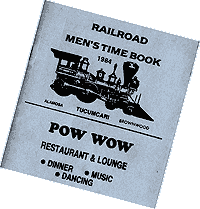 |
1980: The low point... Southern Pacific's portion of the Golden State Route, the Carrizozo Subdivision, reflected the sad state of affairs on the Rock Island. With little originating / terminating traffic, the Sub was a line haul route dependent upon whatever Rock Island could move without derailing. At the same time, the SP was starting to feel the financial pinch that would drive it to seek merger with Santa Fe and later, Rio Grande. Operations subsisted at low ebb for the first months after the takeover. Typically the line hosted only one train each way per day, and Tucumcari had only three regular crews to handle the 330 mile Tucumcari - Carrizozo freight pool. (continued below) |
|||||
 |
||||||
| Rock Island Dalhart Line (Panhandle Division, Second District, Subdivision 42) Employee Timetable, 1-30-49 |
Above and below, we see one-half of the day's activities in June, 1980, as an eastbound exchanges crews, and then makes a setout in the Tucumcari yard. In the lower photo, the crew, now Cotton Belt employees, backs the setout off of the Rock Island Amarillo Main, abandoned beyond Tucumcari six weeks previously. Curving to the left of the lead locomotives is the Cotton belt Dalhart Main leading to Kansas City. The track at far left is the Ballon Track, in the former roundhouse area, used for turning equipment. That dark ballast is cinders from SP's coal burning steam locomotives. Even though the steamers had been gone for thirty years, there were still spots along the line near siding switches where the accumulated cinders from waiting locomotives were still ankle deep. |
Rock Island Amarillo Line (Panhandle Division, Second District, Subdivision 4) Employee Timetable, 1-30-49 | ||||
 |
||||||
 |
NEW 10-27-24: But SP had big plans to better compete with Santa Fe between Chicago and California. In early 1983, the company announced its plans to upgrade the Cotton Rock from Kansas City, Kansas all the way to El Paso. Carrizozo was to be the crew change point while work on the massive project took place. See the Lincoln County News article at left. But SP wasn't waiting for the track upgrade. It progressively added more and more trains to the lineups throughout the course of 1983. This did not go well, as we shall see. |
|||||
|
New 10-27-24: To better orient the reader, we now offer a PDF of E.O.'s well worn working timetable, the last one published during train order operation. click on image |
||||||

NEW 10-27-24: FORMER TIMES: Tucumcari station stop sometime after World War II - photographer unknown - Wx4 Collection |
||||||
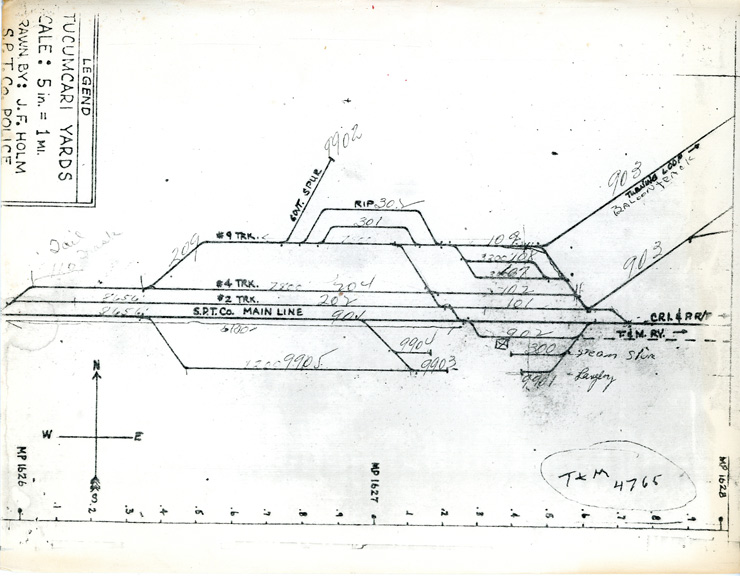
NEW 9-29-2022: SP abandoned Tucumcari in favor of El Paso as a home terminal for crews when traffic fell off to nothing in the 1970's. As a result, most company and local union records went along for the ride. When Tucumcari was re-established to its former status in 1983, both company managers and union officers in the newly reestablished locals found it difficult to impossible to extricate the old records from El Paso for one reason, or another. Because of the paucity of official documentation, SP crew members were forced to use the above rather crudely drawn map as a switching/spotting reference. |
||||||
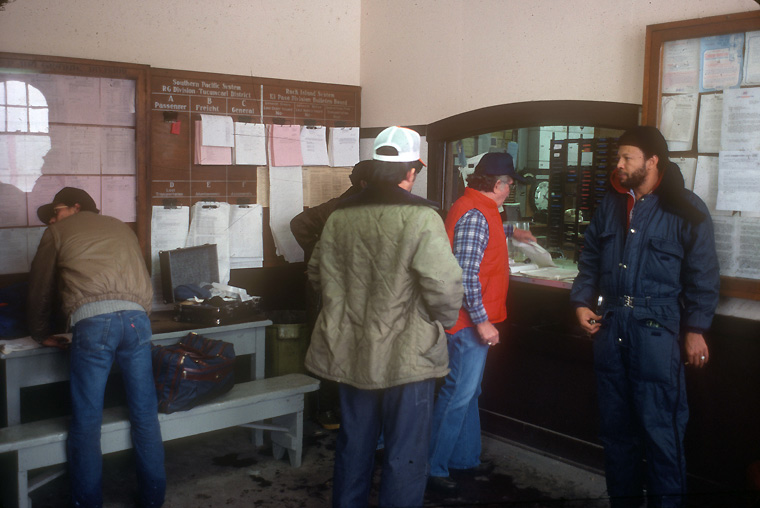
NEW 9-29-2022: A time-honored ritual in the lobby of the Tucumcari yard office - picking up the waybills and train orders, the latter often after a considerable wait for the overworked dispatcher to dictate them. I no longer can conjure up the names of these familiar looking fellows, but I believe that the gentleman in the jumpsuit at right was an on-loan engineer from Cajun Country. - John Signor photo |
||||||
The onset of traffic, construction and headaches... SP held big plans to revive the Golden State Route as a credible competetor to Santa Fe, but a host of problems kept the company perennially cash short, so for the first few years nothing much was done. Traffic did pick up a little, so that by 1981, the line saw about 2-3 trains each way per day. Extensive track rehabillitation finally began in 1983, starting at the west (south) end and progressing north to the extent that the Navahos on the "contract [contractor] gangs" were working well north of Carrizozo by late in the year. These Native Americans could work and drink with the best of them, as I can attest personally. |
||||||
|
NEW 9-29-2022: Below - Vaugn in different times: In 1974 Vaugn depot, close on to where Santa Fe crossed SP on a flyover (in background), functioned as a train order station. Subsequently, SP cut back operations on the Carrizozo Sub, part of which involved shutting down all of the train order offices between Tucumcari and Carrizozo, including Vaugn. This generally was fine as long as only two trains ran over the line, but later proved problematic when SP similtaneously increased traffic and initiated reconstruction on the line. This caused SP to partly reverse course and reopen two intermediate offices, at Vaugn and Santa Rosa. Both towns' depots had deteriorated mightily in the intervening years and were being used by M/W, so the new train order offices were housed in trailers. - photographer unknown, Wx4 Collection
|
||||||
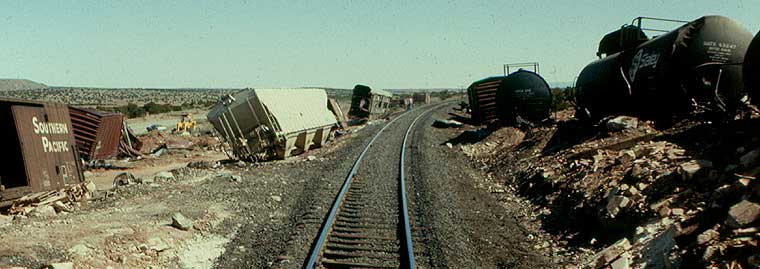 Not helping matters: In the Spring of 1984, a train 'stacked-up' near Ancho, closing the line until the cars could be re-distributed away from the tracks. The company claimed that the engineer created this half-mile stretch of mayhem by speeding through a 30 m.p.h. slow order, although if I recall correctly, they never proved their case because none of the locomotives had event recorders to document the train's speed. |
||||||
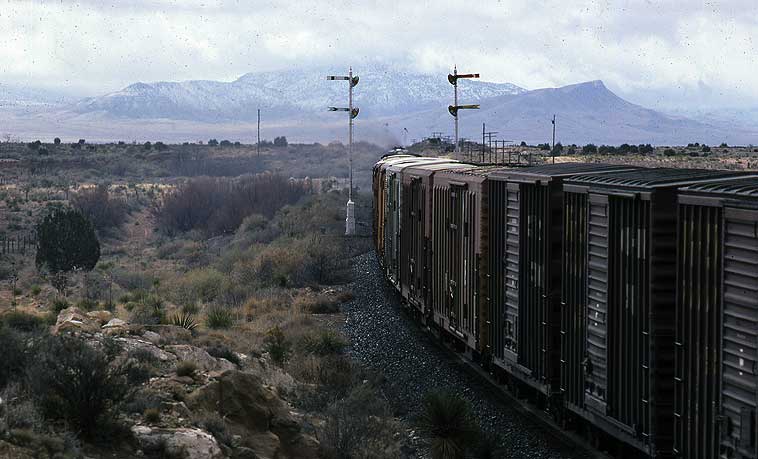 An X-west splitting the semaphores between Ancho and Robsart on March 4, 1983. Gloom obscures Mt. Carrizo ahead. A tie-up in Carrizozo is close at hand. Brian Jennison slide; Wx4 collection.
New 10-27-24: In 1997 UP times, XE SSW 8374 pulls by the Ancho derailment site. - photographer unknown, Wx4 collection |
||||||
|
In the line overhaul, SP also used its own track gangs, also heavily manned with Native Americans. In late 1983, a minor official from Dunsmuir was vacationing in the area and decided to go out and do a little recreational efficiency testing of local employees. At some point, he spotted a track gang leaving the job well before their normal off-duty time. Worse (or better, from the predatory official's standpoint), they headed straight for the local cantina. He waited until they all had drinks in their hands, then burst forth into the watering hole with the announcement that, "I'm Road Foreman blankety blank, and you're all out of service for violating Rule G [consuming alcohol while on duty]." As a result, the gang was a bit taken aback, but not totally non-plussed, and they proceeded to drag the official outside and beat the crap out of him. Afterward, the official called the division superintendent in Tucson to complain about the violations and violence, only to hear, "Who in the hell are you, and what in the hell are you doing on my railroad? The official skulked back to Klamath Falls; retired shortly thereafter; passed away in the early 2000's. I've heard this same general story from several fellow rails, though details vary. |
||||||
|
Carrizozo
|
||||||
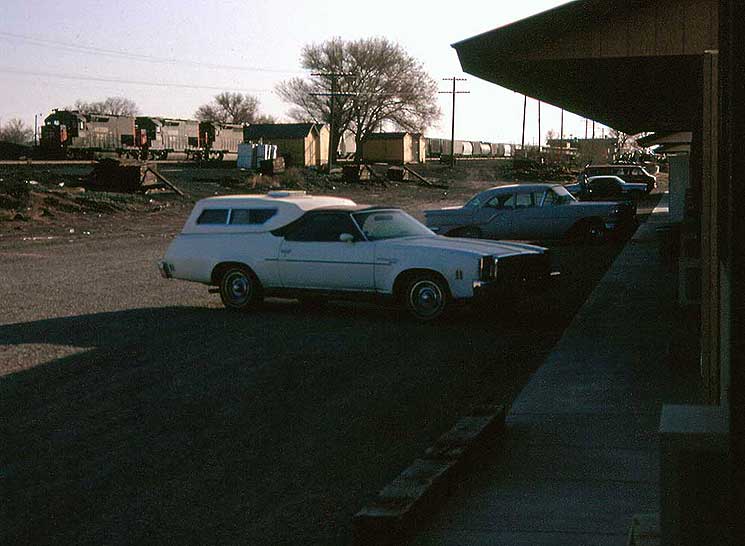 |
||||||
For a few years in the mid-1980's, while SP ironed out the operational wrinkles, Carrizozo returned to its old status as a crew change point on the Tucumcari-El Paso run. The town was no treat: two bars (niether as atmospheric as the jackalope-decorated saloon up at Corona - "Whiskey - The Raod to Ruin"); a handful of mediocre-or-worse restaurants, only one of which stayed open 24 hours under SP contract (the Tradewinds, or "Four Blows"; they served soda crackers with salsa - sacrilege!). Then there was Prem's: This variety store of sorts was run by two old gentlemen of reportedly divergent sexual tastes. One look through the window was enough to scare off most customers. It was that weird. I entered once, and my stongest recollection is of boxes of new shoes...obviously on the shelf since the 1940's. Author John Signor, whose servitude on the Sub predated mine by a few months, also only entered once, and found Kromer caps, Davy Crockett lunch pails, and bought what turned out to be a melted candy bar. Later, old heads told him that if he went back, he was in danger of getting "snake-bit". Although 'Zozo was situated in a relatively pretty high desert setting, the frequent, strong north wind often re-delivered the garbage dump's trash back into town. The business district block near the tracks had burned down some years prior, and the company-provided modular crew quarters, a.k.a. "the modules", contained one TV set in the recreation room; none in the cells. Thankfully, the modules were clean, unlike the pigsty at Ashland, Oregon. |
Map of Carrizozo Sub, 1982
Part 3: Jawbone Dispatching Arrives Train Order Primer (many pages) NEW 10-27-24: April 29, 1984 Tucson Division employee timetable #16 - last timetable issued in train order era; E.O.'s well worn, working copy |
|||||